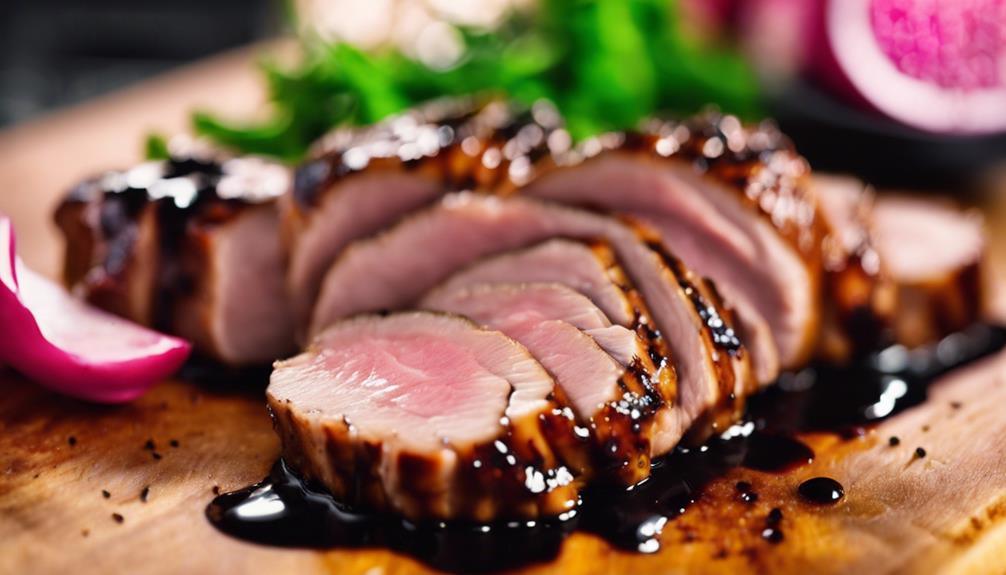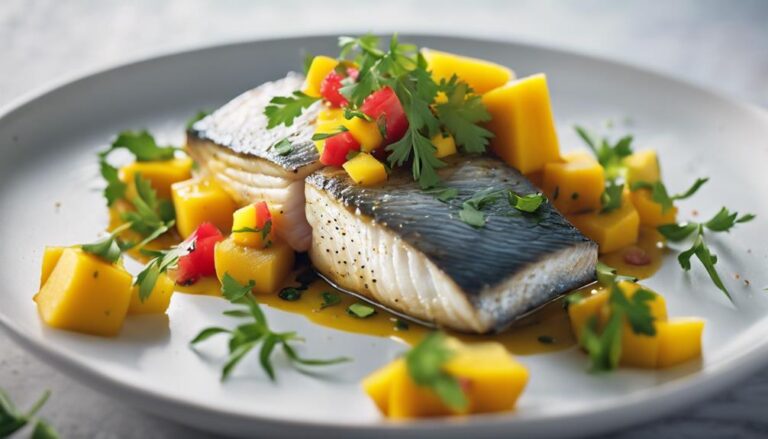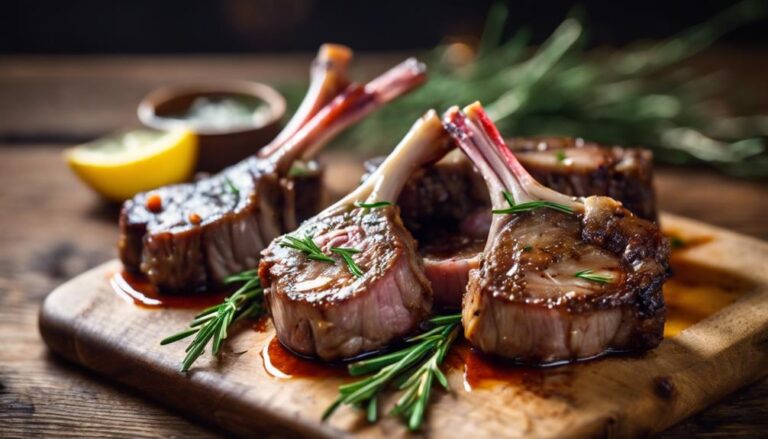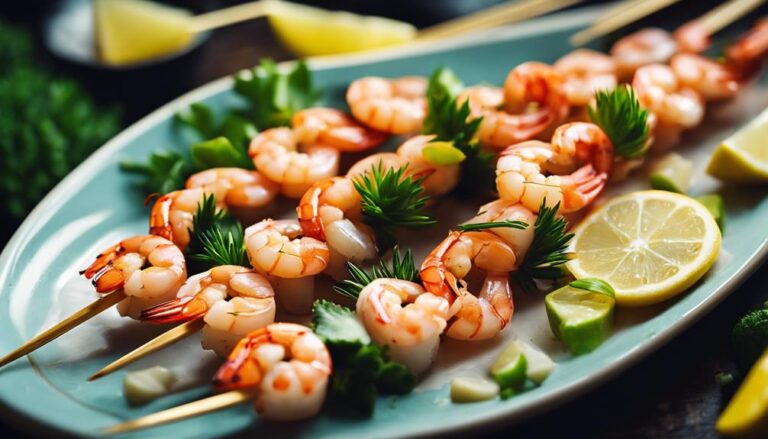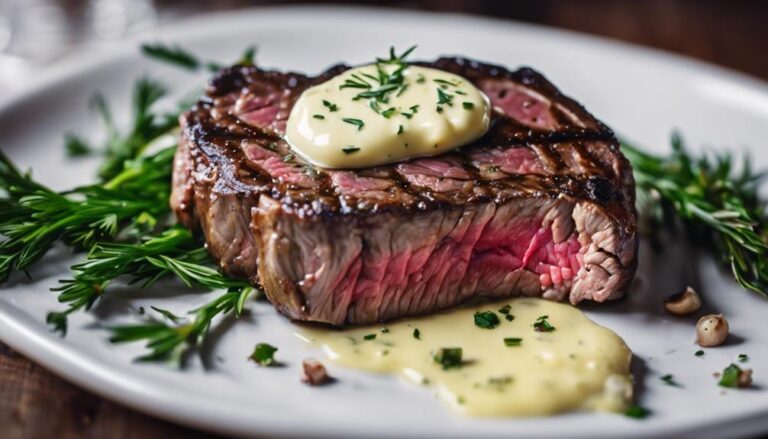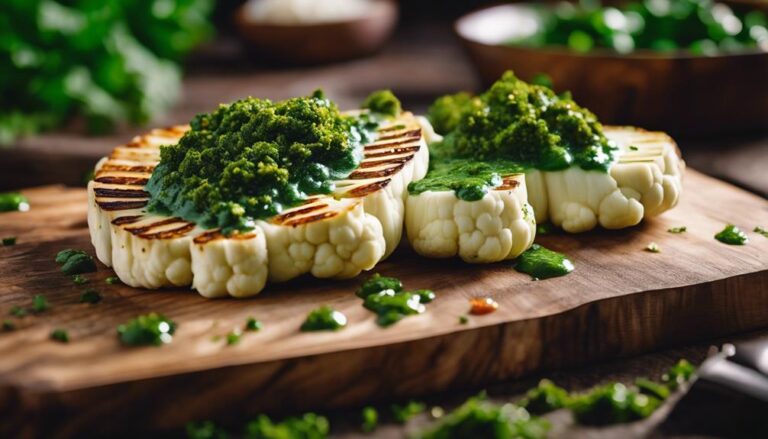Sous Vide Pork Tenderloin With Balsamic Glaze
Achieve perfection with sous vide pork tenderloin coated in delectable balsamic glaze. Seal seasoned pork in a bag, sous vide at 140°F for 2 hours. Sear for a delightful caramelized finish. Whisk balsamic vinegar, honey, and butter for the glaze. Simmer until thickened. Drizzle over the succulent pork. The flavors will dance on your palate, tantalizing your taste buds. Mastering this dish promises a culinary delight that beckons you to explore more culinary wonders.
What You Will Learn Here
- Sous vide cooking ensures precise temperature control for tender pork tenderloin.
- Balsamic glaze adds a sweet and tangy flavor to the dish.
- Searing the pork after sous vide cooking creates a flavorful crust.
- Balancing savory and sweet elements enhances the overall taste profile.
- Attention to marbling and trimming ensures juicy and flavorful results.
Culinary Origins
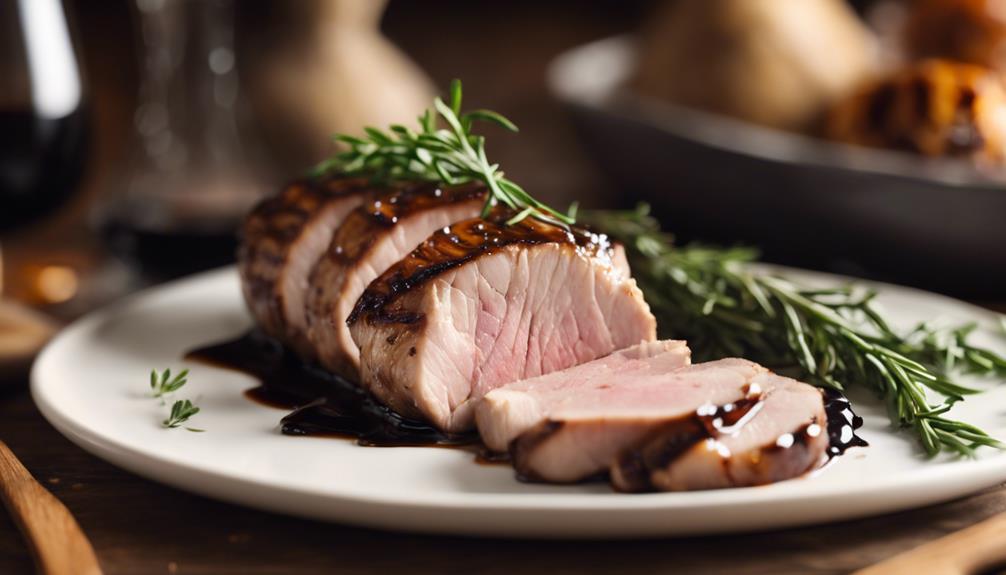
Let's explore the historical roots of sous vide, the diverse cultural influences that have shaped modern cuisine, and the fascinating evolution of cooking techniques.
Understanding the origins of sous vide allows for a deeper appreciation of its development and widespread adoption. Cultural diversity has played a significant role in the innovation and fusion of culinary practices, leading to the diverse range of flavors and techniques we enjoy today.
History of Sous Vide
Sous vide, a cooking technique involving sealing food in airtight bags and cooking it precisely in a water bath, originates from French cuisine. This method's modern applications stem from advancements in culinary science, revolutionizing how food is prepared.
Sous vide equipment enables precision cooking by maintaining a consistent temperature, ensuring perfectly cooked dishes every time. Initially developed in the 1970s, sous vide has since evolved to be a staple in professional kitchens and home cooking alike.
The technique allows for enhanced flavors, textures, and consistency in dishes, making it a favorite among chefs seeking innovation in their culinary creations. Embracing sous vide cooking opens a world of possibilities for experimenting with flavors and transforming ordinary ingredients into extraordinary meals.
Cultural Influences on Cuisine
Culinary origins are deeply intertwined with cultural influences, shaping the way dishes are prepared and enjoyed around the world. Cultural fusion plays a significant role in modern cuisine, blending traditional flavors with innovative techniques to create unique culinary experiences.
Traditional flavors, rooted in the history and heritage of different regions, provide a foundation for chefs to experiment and push boundaries in the kitchen. By infusing elements from diverse cultures, chefs can create dishes that resonate with a global audience, celebrating the richness of culinary diversity.
This interplay of cultural influences not only enriches the dining experience but also highlights the interconnectedness of food traditions worldwide, fostering a deep appreciation for the depth and complexity of flavors that have evolved over centuries.
Evolution of Cooking Techniques
In the domain of culinary origins, the evolution of cooking techniques has been a dynamic process driven by innovation and practicality. Cooking evolution over centuries has seen a shift from traditional open-flame cooking methods to modern techniques like sous vide and molecular gastronomy.
The desire for efficiency and precision has led to the development of tools such as immersion circulators and thermal circulators, revolutionizing the way food is prepared. These modern methods allow for consistent results, enhanced flavors, and precise control over cooking temperatures.
As chefs continue to experiment and push boundaries, the evolution of cooking techniques remains at the forefront of culinary innovation, shaping the way we approach food preparation and creating new possibilities in the kitchen.
Key Pork Tenderloin Components
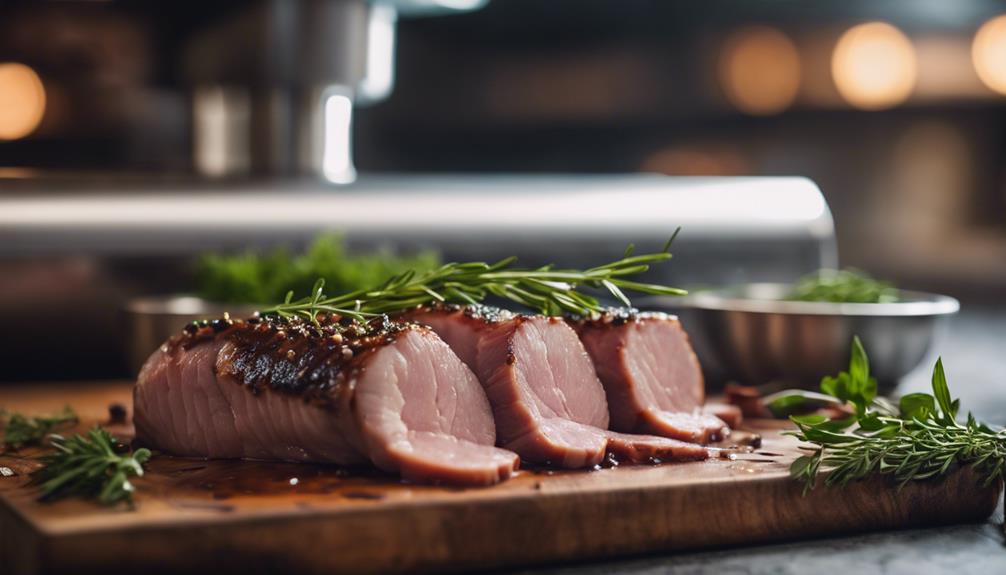
To enhance the flavor and tenderness of pork tenderloin, focus on selecting the right cut, trimming excess fat, and marinating for best results. When preparing pork tenderloin, keep these key components in mind:
- Selecting the Right Cut: Opt for a pork tenderloin cut that's fresh, pink-hued, and firm to the touch. Look for marbling within the meat, as this will enhance the juiciness and flavor of the dish. Avoid cuts that appear discolored or have a strong odor, as these may indicate spoilage.
- Trimming Excess Fat: Before cooking, trim any excess fat from the pork tenderloin. While some fat can add flavor, too much can lead to a greasy or chewy texture. Removing visible fat will also promote even cooking and browning of the meat.
- Marinating for Best Results: Marinating the pork tenderloin before cooking can infuse it with additional flavor and help tenderize the meat. Choose a marinade that complements the natural sweetness of pork, such as a mixture of herbs, garlic, and citrus juices. Allow the pork to marinate for at least 30 minutes, or ideally overnight, for the flavors to fully develop.
Tasty Pork Tenderloin Variations
You can elevate your pork tenderloin dishes by trying out a savory sous vide pork recipe that guarantees juicy and tender meat.
Another delicious variation to contemplate is a honey-glazed pork loin, adding a perfect balance of sweet and savory flavors to your meal.
For a delightful twist, experiment with pork tenderloin stuffed with apples for a delightful combination of fruity sweetness and savory pork goodness.
Savory Sous Vide Pork Recipe
For a delectable twist on traditional pork tenderloin, consider experimenting with different seasoning blends and marinades when preparing your savory sous vide pork recipe.
- Sous Vide Techniques: Try using sous vide to cook your pork tenderloin to perfection, ensuring a tender and juicy result every time.
- Flavor Profiles: Explore various flavor profiles such as Asian-inspired marinades with soy sauce, ginger, and garlic for a unique twist on your pork tenderloin.
- Cooking Tips: Remember to sear your pork tenderloin after it's done cooking sous vide to create a beautiful crust and enhance the flavors of the dish.
Honey-Glazed Pork Loin
Discover the delightful flavors of honey-glazed pork loin to elevate your culinary experience with these tasty pork tenderloin variations. When preparing this succulent dish, the sweet glaze perfectly complements the tender pork loin, creating a harmonious balance of flavors that will leave your taste buds craving for more.
Here are three innovative ways to enjoy honey-glazed pork loin:
- Grilled Perfection: Marinate the pork loin in a honey glaze and grill it to perfection for a smoky flavor that enhances the sweetness of the glaze.
- Oven-Baked Elegance: Slow roast the pork loin in the oven with the sweet glaze, allowing the flavors to meld together while keeping the meat tender and juicy.
- Sous Vide Sophistication: Utilize the sous vide cooking method to achieve precise temperature control, resulting in a perfectly cooked honey-glazed pork loin that's juicy and full of flavor.
Pork Tenderloin Stuffed With Apples
Stuffed with a savory apple filling, pork tenderloin offers a delectable twist on traditional pork dishes. The apple stuffing complements the tender pork, creating a harmonious blend of sweet and savory flavors.
To prepare this innovative dish, follow these steps:
- Prep the Pork: Butterfly the pork tenderloin to create a pocket for the apple stuffing.
- Make the Apple Filling: Combine diced apples, breadcrumbs, herbs, and a touch of cinnamon for a fragrant and delicious stuffing.
- Assemble and Cook: Fill the pork with the apple mixture, secure with kitchen twine, and roast until the pork is cooked through and the apples are tender.
Enjoy a unique and flavorful pork tenderloin experience!
Searing for Added Flavor
When searing your sous vide pork tenderloin, you're not just adding color – you're enhancing its flavor profile. The Maillard reaction that occurs during searing is essential for developing rich, complex tastes.
Additionally, searing creates a delightful texture and appealing appearance that elevate the overall dining experience.
Enhancing Flavor Through Searing
To enhance the flavors and create a desirable crust on your sous vide pork tenderloin, searing it in a hot skillet with a touch of oil is essential. Searing not only enhances the taste by developing a flavorful crust but also adds visual appeal with a beautifully caramelized exterior.
When the pork tenderloin is carefully seared after sous vide cooking, a Maillard reaction occurs, resulting in a depth of flavor that complements the tenderness achieved through the sous vide method. The high heat applied during searing caramelizes the natural sugars in the meat, creating a delicious complexity that elevates the overall dining experience.
Maillard Reaction Importance
As you sear your sous vide pork tenderloin, the Maillard reaction plays an essential role in intensifying the flavors and adding depth to your dish. This chemical reaction occurs between amino acids and reducing sugars when exposed to high heat, creating a complex range of new flavors and aromas.
The Maillard reaction is vital in developing the rich umami taste and enhancing the overall taste profile of your pork tenderloin. By employing proper cooking techniques that promote the Maillard reaction, such as searing at the right temperature for the right amount of time, you can elevate the dish's flavor development significantly.
Understanding the importance of the Maillard reaction can take your culinary skills to new heights, allowing you to create dishes with exceptional depth and complexity.
Texture and Appearance Benefits
Enhance the texture and appearance of your sous vide pork tenderloin by expertly searing it to achieve a flavorful caramelized crust.
Searing the pork after it has been cooked sous vide not only adds a delicious depth of flavor but also provides texture benefits by creating a crispy exterior that contrasts beautifully with the tender, juicy interior.
The Maillard reaction that occurs during searing results in a visually appealing golden-brown color that entices the eyes before even taking the first bite.
This combination of a caramelized crust and succulent meat not only elevates the taste profile but also adds a professional touch to your dish, making it a visually stunning centerpiece for your dining experience.
Final Thoughts
Consider the key elements that contribute to the overall success of your Sous Vide Pork Tenderloin dish before you plate and serve it to guarantee a memorable dining experience. Upon reflection, the significance of the sous vide cooking method plays a vital role in ensuring that your pork tenderloin is perfectly cooked to the desired doneness. The controlled temperature and extended cooking time result in a tender and juicy texture that's hard to achieve through traditional cooking methods.
Furthermore, the balsamic glaze adds a layer of complexity to the dish, balancing the savory flavors of the pork with a touch of sweetness and acidity. When plating your dish, pay attention to the aesthetics – a visually appealing presentation can elevate the dining experience and make your meal even more enticing.
Frequently Asked Questions
Can This Recipe Be Adapted for Other Types of Meat Besides Pork Tenderloin?
You can adapt this recipe for various meat alternatives like chicken breasts or beef cuts. Adjust cooking variations based on meat thickness and texture. Experiment with flavors by trying different marinades or sauces. Sous vide tips guarantee precise results.
How Can I Adjust the Cooking Time and Temperature for a Larger or Smaller Pork Tenderloin?
When adjusting cooking time and temperature for a larger or smaller pork tenderloin, guarantee even cooking by increasing or decreasing sous vide duration accordingly. Adjust temperature slightly for size variations, maintaining a safe, succulent result.
Can I Substitute the Balsamic Glaze With a Different Sauce or Marinade?
You can definitely switch the balsamic glaze with various flavorful options like honey mustard, teriyaki, or chimichurri for diverse taste profiles. Experimenting with different sauces or marinades can elevate your dish to new heights.
Is It Necessary to Marinate the Pork Tenderloin Before Cooking Sous Vide?
Marinating pork tenderloin before sous vide cooking can enhance flavors and tenderize the meat. Benefits include deeper taste infusion and increased tenderness. Drawbacks may include longer prep time and potentially overpowering seasonings.
Can I Finish the Pork Tenderloin on the Grill Instead of Searing It in a Pan?
You can definitely finish the pork tenderloin on the grill for a smoky flavor alternative. Consider using charcoal for a richer taste or gas for convenience. Searing directly over high heat creates a nice crust.
Conclusion
To summarize, sous vide pork tenderloin with balsamic glaze is a delicious and tender dish that showcases the versatility and flavor of this cut of meat. By using the sous vide method, you can achieve perfectly cooked pork every time.
The addition of a balsamic glaze adds a sweet and tangy element that complements the pork beautifully. Searing the pork before serving adds a nice caramelized crust and enhances the overall flavor profile.
Enjoy this dish for a gourmet experience at home.
